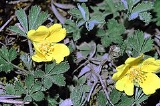
Potentilla
Encyclopedia
Potentilla is the genus
of typical cinquefoils, containing about 500 species
of annual
, biennial
and perennial
herb
s in the rose family Rosaceae
. They are generally Holarctic
in distribution, though some may even be found in montane
biome
s of the New Guinea Highlands
. Several other "cinquefoils" formerly included here are now separated in distinct genera.
Some species are called tormentils, though this often is used as a shorthand for Common Tormentil (P. erecta). Others are referred to as "barren strawberries", which may also refer to P. sterilis in particular, or to the closely related but not congener
ic Waldsteinia fragarioides
.
The word is derived from Old French
cinc, Middle English
cink and ultimately Latin quinque – all meaning "five" –, and feuille and foil/foille which mean "leaf". Formerly this term referred to five-leaved plants in general. In Medieval times, the word "cinquefoil" was used almost exclusively in England. In France, the genus was called quintefeuille, first attested in Normandy
and Brittany
in the 11th century.
The scientific name seems to have been influenced by a fusion of ancient names for these plants: Common Tormentil (P. erecta) was known as tormentilla in Medieval Latin
, derived from early Spanish – literally "a little torment", meaning pain
that while not debilitating is unpleasant and persistent (such as a belly ache, against which P. erecta was used). The change from initial "t" to "p" seems to have been influenced by terms such as poterium – Latin for the related burnet
s (Sanguisorba) –, or propedila and similar words used for the Creeping Cinquefoil
(P. reptans) in the now-extinct Dacian language
, as attested in Latin herbal
s.
In A Dictionarie of the French and English Tongues, compiled by Randle Cotgrave
in 1611, the French word potentille is defined as a "wild Tansie, a silver weed" – i.e. any of several composite plants of the genus Tanacetum
especially T. vulgare. The related adjective
potentiel/potentiells means "strong", "forcible" or "powerful in operation". Its origin is the French potence ("strong", "powerful", "mighty" or "potent"). The origin of these words is the Latin potens, with the same meaning.
are usually dry but may be fleshy and strawberry
-like, while the actual seeds – each one technically a single fruit – are tiny nut
s. Cinquefoils grow wild in most cool and cold regions of the world. Most species are herbs but a few are erect or creeping shrub
s. Some Cinquefoils are troublesome weed
s. Other types are grown in gardens.
Cinquefouls are a prominent part of many ecosystem
s. In the United Kingdom
alone, Common Tormentil (P. erecta) together with Purple Moor Grass
(Molinia caerulea) defines many grassy mire
s, and grows abundantly in the typical deciduous forest rich in Downy Birch
(Betula pubescens) Common Wood-sorrel (Oxalis acetosella) and Sessile Oak
(Quercus petraea). In upland pastures on calcareous
soil it typically accompanies Common Bent (Agrostis capillaris), Sheep's Fescue
(Festuca ovina) and Mother-of-Thyme (Thymus praecox). The boggy heathlands of southern Britain
dominated by Bristle Bent (A. curtisii) and Western Gorse (Ulex gallii) as well as those on The Lizard
peninsula, characterized by Cornish Heath
(Erica vagans) and Black Bog-rush (Schoenus nigricans
), are also usually inhabited by the Common Tormentil. But it is most commonly seen in regions dominated by Common Heather (Calluna vulgaris) – be it the common lowland heaths rich in Bell Heather (Erica cinerea), maritime heath where Spring Squill (Scilla verna) grows in abundance, the submontane heaths of the north dominated by the peat moss Sphagnum capillifolium
and Bilberry
(Vaccinium myrtillus), or montane
heathlands of Scotland
with plentiful Alpine Juniper (Juniperus communis ssp. alpina).
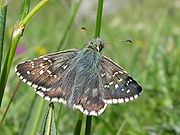 Spring Cinquefoil (P. neumanniana) on the other hand is rare in Britain, found generally only in some southern calcareous grassland
Spring Cinquefoil (P. neumanniana) on the other hand is rare in Britain, found generally only in some southern calcareous grassland
s rich in Sheep's Fescue; in the southwest it associates with Carline Thistle (Carlina vulgaris), whereas in the southeast it is usually accompanied by Mouse-ear Hawkweed
(Hieracium pilosella) and either or both Mother-of-Thyme and Large Thyme (T. pulegioides).
The leaves of some cinquefoils are eaten by the caterpillar
s of some Lepidoptera
(butterflies and moth
s), in particular grizzled skippers
(Pyrgus) of the Hesperiidae; see list of Lepidoptera that feed on Potentilla. The plants' flowers are also occasionally visited by adult Lepidoptera; the endangered Karner Blue
(Lycaeides melissa samuelis) for example includes nectar of Common Cinquefoil (P. simplex) among its common food sources. Polish Cochineal
(Porphyrophora polonica), in former times commercially important in crimson
dye
production, is a notable parasite
of cinquefoils on sandy soils of Eastern Europe
and western Asia
.
The flowers of cinquefoils are pollinated by such insects as the Fernald cuckoo bumble bee, Bombus fernaldae
.
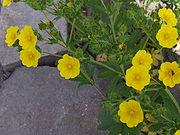 Some of the typical cinquefoils are grown as ornamental plant
Some of the typical cinquefoils are grown as ornamental plant
s. These are generally high species with bright, showy flowers, such as P. atrosanguinea, P. nepalensis and Sulphur Cinquefoil (P. recta). Horticultural hybrids such as Hopwood's Cinquefoil (P. × hopwoodiana) and Tongue Cinquefoil (P. × tonguei) have also been bred, and there exists a range of cultivar
s. Even double-flowered
cinquefoils have been bred, starting with Victor Lemoine
's 1854 'Gloire de Nancy'. Other species are useful for more specialized gardening purposes, such as rock garden
s or swamp
s. Among the former is the hardy Spring Cinquefoil (P. neumanniana), the floral emblem
of Cromartyshire
.
Some species are used in herbalism
. P. fragarioides
contains D-Catechin
and is used as a hemostatic in Traditional Chinese Medicine
, while Common Tormentil (P. erecta) was similarly used in Europe
an folk medicine
, and also to treat diarrhea
and other gastrointestinal ailments. It is rich in flavonoid
s, saponin
s, tannin
s, as well as phenol
and the glycoside
tormentilline, and has been shown to be bacteriostatic and virostatic. It also contains the red dye
tormentole and was sometimes used to colour leather and other materials in former times.
Common Tormentil has also been used in transplant research
, demonstrating that these are useful to distinguish between subspecies
, and form
s and varieties: the former are distinct populations with strongly heritable traits, while the latter two have distinguishing traits produced by ecological conditions and often not inheritable.
In heraldry
, the cinquefoil emblem or "potentilla" signified strength, power, honor and loyalty. Depiction of the five-petal
ed flower appears as early as 1033, in the architecture of the church built in the village of Reulle-Vergy
(Burgundy, France), two years before the reign of William the Conqueror. The cinquefoil emblem was used generously in the architecture of numerous churches built in Normandy and Brittany, through the 15th century.
From the 11th to 14th century, the word potence – related to Potentilla, as per above – was used mainly in a military context and to describe the condition of the soul. During the time of William the Conqueror, the potentilla was used as an emblem on the coat of arms
of Bardolph of Bretagne, who in 1066 was the master of the William's military engineer
corps.
DNA sequence
data has yielded valuable information on cinquefoil relationships, supporting previous hypotheses about their relationships but also resulting in a number of changes to the circumscription of Potentilla:
 Among the Rosidae
Among the Rosidae
, the typical cinquefoils are close relatives of such plants as the avens of genus Geum
and the roses (Rosa
), and even closer relatives of the agrimonies (Agrimonia). Yet more closely related to Potentilla are the lady's mantles (Alchemilla
) and strawberries (Fragaria). The avens of genus Dryas
are not as closely related as long believed though.
The genera Duchesnea (Mock Strawberry), Horkelia
(horkelias), and Ivesia
(mousetails), previously all regarded as distinct, are often but not universally included in Potentilla today. Conversely, the shrub
by plants previously included in this genus are well distinct and now separated in the genus Dasiphora
, while some distinctive and apparently protocarnivorous
herbaceous cinquefoils are placed in Drymocallis
. Marsh Cinquefoil and the disputed Potentilla salesowianum are now separated into the genus Comarum
, and the Three-toothed Cinquefoil is transferred to the monotypic
genus Sibbaldiopsis. As already proposed by John Hill
in the 18th century, the silverweed
s are probably also separable as genus Argentina, though as it seems they are the immediate sister genus of Potentilla: as the boundary between them remains to be defined in detail, it is not inconceivable that the silverweeds will in the future again be included with the typical cinquefoils in a single genus.
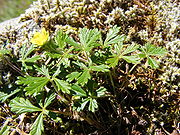
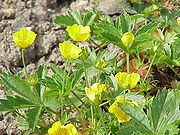
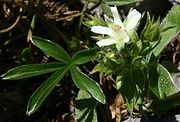
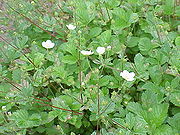
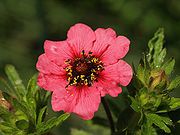
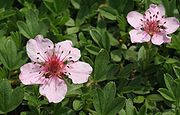
Genus
In biology, a genus is a low-level taxonomic rank used in the biological classification of living and fossil organisms, which is an example of definition by genus and differentia...
of typical cinquefoils, containing about 500 species
Species
In biology, a species is one of the basic units of biological classification and a taxonomic rank. A species is often defined as a group of organisms capable of interbreeding and producing fertile offspring. While in many cases this definition is adequate, more precise or differing measures are...
of annual
Annual plant
An annual plant is a plant that usually germinates, flowers, and dies in a year or season. True annuals will only live longer than a year if they are prevented from setting seed...
, biennial
Biennial plant
A biennial plant is a flowering plant that takes two years to complete its biological lifecycle. In the first year the plant grows leaves, stems, and roots , then it enters a period of dormancy over the colder months. Usually the stem remains very short and the leaves are low to the ground, forming...
and perennial
Perennial plant
A perennial plant or simply perennial is a plant that lives for more than two years. The term is often used to differentiate a plant from shorter lived annuals and biennials. The term is sometimes misused by commercial gardeners or horticulturalists to describe only herbaceous perennials...
herb
Herbaceous
A herbaceous plant is a plant that has leaves and stems that die down at the end of the growing season to the soil level. They have no persistent woody stem above ground...
s in the rose family Rosaceae
Rosaceae
Rosaceae are a medium-sized family of flowering plants, including about 2830 species in 95 genera. The name is derived from the type genus Rosa. Among the largest genera are Alchemilla , Sorbus , Crataegus , Cotoneaster , and Rubus...
. They are generally Holarctic
Holarctic
The Holarctic ecozone refers to the habitats found throughout the northern continents of the world as a whole. This region is divided into the Palearctic, consisting of Northern Africa and all of Eurasia, with the exception of Southeast Asia and the Indian subcontinent, and the Nearctic,...
in distribution, though some may even be found in montane
Montane
In biogeography, montane is the highland area located below the subalpine zone. Montane regions generally have cooler temperatures and often have higher rainfall than the adjacent lowland regions, and are frequently home to distinct communities of plants and animals.The term "montane" means "of the...
biome
Biome
Biomes are climatically and geographically defined as similar climatic conditions on the Earth, such as communities of plants, animals, and soil organisms, and are often referred to as ecosystems. Some parts of the earth have more or less the same kind of abiotic and biotic factors spread over a...
s of the New Guinea Highlands
New Guinea Highlands
The New Guinea Highlands, also known as the Central Range or Central Cordillera, are a chain of mountain ranges and intermountain river valleys, many of which support thriving agricultural communities, on the large island of New Guinea, which lies to the north of Australia...
. Several other "cinquefoils" formerly included here are now separated in distinct genera.
Some species are called tormentils, though this often is used as a shorthand for Common Tormentil (P. erecta). Others are referred to as "barren strawberries", which may also refer to P. sterilis in particular, or to the closely related but not congener
Congener
Congener has several different meanings depending on the field in which it is used. Colloquially, it is used to mean a person or thing like another, in character or action.-Biology:In biology, congeners are organisms within the same genus...
ic Waldsteinia fragarioides
Waldsteinia fragarioides
Waldsteinia fragarioides , also called Barren strawberry, is a low, spreading plant with showy yellow flowers that appear in early spring...
.
Nomenclature
"Cinquefoil" in the Middle English Dictionary by Sherman M. Kuhn, is described as "Pentafilon – From Greek Pentaphyllon – influenced by foil, a leaf. The European cinquefoil (Potentilla reptans), often used medicinally."The word is derived from Old French
Old French
Old French was the Romance dialect continuum spoken in territories that span roughly the northern half of modern France and parts of modern Belgium and Switzerland from the 9th century to the 14th century...
cinc, Middle English
Middle English
Middle English is the stage in the history of the English language during the High and Late Middle Ages, or roughly during the four centuries between the late 11th and the late 15th century....
cink and ultimately Latin quinque – all meaning "five" –, and feuille and foil/foille which mean "leaf". Formerly this term referred to five-leaved plants in general. In Medieval times, the word "cinquefoil" was used almost exclusively in England. In France, the genus was called quintefeuille, first attested in Normandy
Normandy
Normandy is a geographical region corresponding to the former Duchy of Normandy. It is in France.The continental territory covers 30,627 km² and forms the preponderant part of Normandy and roughly 5% of the territory of France. It is divided for administrative purposes into two régions:...
and Brittany
Brittany
Brittany is a cultural and administrative region in the north-west of France. Previously a kingdom and then a duchy, Brittany was united to the Kingdom of France in 1532 as a province. Brittany has also been referred to as Less, Lesser or Little Britain...
in the 11th century.
The scientific name seems to have been influenced by a fusion of ancient names for these plants: Common Tormentil (P. erecta) was known as tormentilla in Medieval Latin
Medieval Latin
Medieval Latin was the form of Latin used in the Middle Ages, primarily as a medium of scholarly exchange and as the liturgical language of the medieval Roman Catholic Church, but also as a language of science, literature, law, and administration. Despite the clerical origin of many of its authors,...
, derived from early Spanish – literally "a little torment", meaning pain
Pain
Pain is an unpleasant sensation often caused by intense or damaging stimuli such as stubbing a toe, burning a finger, putting iodine on a cut, and bumping the "funny bone."...
that while not debilitating is unpleasant and persistent (such as a belly ache, against which P. erecta was used). The change from initial "t" to "p" seems to have been influenced by terms such as poterium – Latin for the related burnet
Sanguisorba
Sanguisorba is a genus of perennial herbs or small shrubs in the family Rosaceae, native to the temperate regions of the Northern Hemisphere. The common name is Burnet. The stems grow to 50-200 cm tall, with a cluster of basal leaves, and further leaves arranged alternately up the stem...
s (Sanguisorba) –, or propedila and similar words used for the Creeping Cinquefoil
Creeping Cinquefoil
Potentilla reptans, known as the creeping cinquefoil, European cinquefoil or creeping tormentil, is a plant in the Rosaceae family....
(P. reptans) in the now-extinct Dacian language
Dacian language
The extinct Dacian language may have developed from proto-Indo-European in the Carpathian region around 2,500 BC and probably died out by AD 600. In the 1st century AD, it was the predominant language of the ancient regions of Dacia and Moesia and, possibly, of some surrounding regions.It belonged...
, as attested in Latin herbal
Herbal
AThe use of a or an depends on whether or not herbal is pronounced with a silent h. herbal is "a collection of descriptions of plants put together for medicinal purposes." Expressed more elaborately — it is a book containing the names and descriptions of plants, usually with information on their...
s.
In A Dictionarie of the French and English Tongues, compiled by Randle Cotgrave
Randle Cotgrave
Randle Cotgrave , may possibly be Randal, son of William Cotgreve of Christleton in Cheshire, who is mentioned in the pedigree of the Cotgreve family, contained in Harl. MS. 1500, fol...
in 1611, the French word potentille is defined as a "wild Tansie, a silver weed" – i.e. any of several composite plants of the genus Tanacetum
Tanacetum
Tanacetum is a genus of about 160 species of flowering plant in the family Asteraceae, native to many regions of the Northern Hemisphere.Common names include Tansy , Costmary , and Feverfew ; several other species are also known as tansies.Tanacetum species...
especially T. vulgare. The related adjective
Adjective
In grammar, an adjective is a 'describing' word; the main syntactic role of which is to qualify a noun or noun phrase, giving more information about the object signified....
potentiel/potentiells means "strong", "forcible" or "powerful in operation". Its origin is the French potence ("strong", "powerful", "mighty" or "potent"). The origin of these words is the Latin potens, with the same meaning.
Description and ecology
Typical cinquefoils look most similar to the strawberries, but differ in usually having dry, inedible fruit (hence the name "barren strawberry" for some species). Many cinquefoil species have leaves divided into five leaflets arranged palmately like the fingers of a hand. Because of such shape of leaves, some species are called five-finger. Some species, such as the Barren Strawberry, have just three leaflets, and others (e.g. P. anserina) up to 15 or more leaflets arranged pinnately. The flowers are usually yellow, but may be white, pinkish or even red; the accessory fruitAccessory fruit
An accessory fruit is a fruit in which some of the flesh is derived not from the ovary but from some adjacent tissue exterior to the carpel. Examples of accessory tissue are the receptacle of strawberries, figs, or mulberries, and the calyx of Gaultheria procumbens or Syzygium jambos...
are usually dry but may be fleshy and strawberry
Strawberry
Fragaria is a genus of flowering plants in the rose family, Rosaceae, commonly known as strawberries for their edible fruits. Although it is commonly thought that strawberries get their name from straw being used as a mulch in cultivating the plants, the etymology of the word is uncertain. There...
-like, while the actual seeds – each one technically a single fruit – are tiny nut
Nut (fruit)
A nut is a hard-shelled fruit of some plants having an indehiscent seed. While a wide variety of dried seeds and fruits are called nuts in English, only a certain number of them are considered by biologists to be true nuts...
s. Cinquefoils grow wild in most cool and cold regions of the world. Most species are herbs but a few are erect or creeping shrub
Shrub
A shrub or bush is distinguished from a tree by its multiple stems and shorter height, usually under 5–6 m tall. A large number of plants may become either shrubs or trees, depending on the growing conditions they experience...
s. Some Cinquefoils are troublesome weed
Weed
A weed in a general sense is a plant that is considered by the user of the term to be a nuisance, and normally applied to unwanted plants in human-controlled settings, especially farm fields and gardens, but also lawns, parks, woods, and other areas. More specifically, the term is often used to...
s. Other types are grown in gardens.
Cinquefouls are a prominent part of many ecosystem
Ecosystem
An ecosystem is a biological environment consisting of all the organisms living in a particular area, as well as all the nonliving , physical components of the environment with which the organisms interact, such as air, soil, water and sunlight....
s. In the United Kingdom
United Kingdom
The United Kingdom of Great Britain and Northern IrelandIn the United Kingdom and Dependencies, other languages have been officially recognised as legitimate autochthonous languages under the European Charter for Regional or Minority Languages...
alone, Common Tormentil (P. erecta) together with Purple Moor Grass
Purple Moor Grass
Molinia caerulea is a perennial grass native to Europe, west Asia, and north Africa. It grows in locations from the lowlands up to 2,300 m in the Alps. Like most grasses, it grows best in acid soils, ideally pH values of between 3.5 and 5, however, it can continue to live under more extreme...
(Molinia caerulea) defines many grassy mire
Miré
Miré is a commune in the Maine-et-Loire department in western France....
s, and grows abundantly in the typical deciduous forest rich in Downy Birch
Downy Birch
Betula pubescens is a species of birch, native and abundant throughout northern Europe, Iceland, northern Asia and also Greenland....
(Betula pubescens) Common Wood-sorrel (Oxalis acetosella) and Sessile Oak
Sessile Oak
Quercus petraea , the Sessile Oak, also known as the Durmast Oak, is a species of oak native to most of Europe, and into Anatolia.-Description:...
(Quercus petraea). In upland pastures on calcareous
Calcareous
Calcareous is an adjective meaning mostly or partly composed of calcium carbonate, in other words, containing lime or being chalky. The term is used in a wide variety of scientific disciplines.-In zoology:...
soil it typically accompanies Common Bent (Agrostis capillaris), Sheep's Fescue
Sheep's Fescue
Sheep's Fescue or Sheep Fescue is a species of grass.-General Description:It is a perennial plant sometimes found in acidic ground, for example in the Portlethen Moss, Scotland and mountain pasture, throughout Europe and eastwards across much of Asia; it has also been introduced to North...
(Festuca ovina) and Mother-of-Thyme (Thymus praecox). The boggy heathlands of southern Britain
United Kingdom
The United Kingdom of Great Britain and Northern IrelandIn the United Kingdom and Dependencies, other languages have been officially recognised as legitimate autochthonous languages under the European Charter for Regional or Minority Languages...
dominated by Bristle Bent (A. curtisii) and Western Gorse (Ulex gallii) as well as those on The Lizard
The Lizard
The Lizard is a peninsula in south Cornwall, England, United Kingdom. The most southerly point of the British mainland is near Lizard Point at ....
peninsula, characterized by Cornish Heath
Cornish heath
The Cornish heath is a species of heath that bears pink flowers and mid-green foliage. This is a shrub, reaching 0.75 m by 0.75 m. Its English name comes from the fact that, in Great Britain, it is only found on the Lizard peninsula in Cornwall, where the unusual geology gives rise to the alkaline...
(Erica vagans) and Black Bog-rush (Schoenus nigricans
Schoenus nigricans
Schoenus nigricans is a species of sedge known by the common name black bogrush. It is native to Eurasia, parts of Africa, Australia, and southern North America, including Mexico and the southernmost United States. It grows in many types of wetlands and other moist and alkaline habitat, including...
), are also usually inhabited by the Common Tormentil. But it is most commonly seen in regions dominated by Common Heather (Calluna vulgaris) – be it the common lowland heaths rich in Bell Heather (Erica cinerea), maritime heath where Spring Squill (Scilla verna) grows in abundance, the submontane heaths of the north dominated by the peat moss Sphagnum capillifolium
Sphagnum capillifolium
Sphagnum capillifolium, the small red peat moss, is a species of peat moss native to Canada, the northern United States, Greenland and Europe. Small red peat can be distinguished by its sweeping, outward-curving branches that resemble tresses....
and Bilberry
Bilberry
Bilberry is any of several species of low-growing shrubs in the genus Vaccinium , bearing edible berries. The species most often referred to is Vaccinium myrtillus L., but there are several other closely related species....
(Vaccinium myrtillus), or montane
Montane
In biogeography, montane is the highland area located below the subalpine zone. Montane regions generally have cooler temperatures and often have higher rainfall than the adjacent lowland regions, and are frequently home to distinct communities of plants and animals.The term "montane" means "of the...
heathlands of Scotland
Scotland
Scotland is a country that is part of the United Kingdom. Occupying the northern third of the island of Great Britain, it shares a border with England to the south and is bounded by the North Sea to the east, the Atlantic Ocean to the north and west, and the North Channel and Irish Sea to the...
with plentiful Alpine Juniper (Juniperus communis ssp. alpina).

Calcareous grassland
Calcareous grassland is an ecosystem associated with thin basic soil, such as that on chalk and limestone downland. Plants on calcareous grassland are typically short and hardy, and include grasses and herbs such as clover...
s rich in Sheep's Fescue; in the southwest it associates with Carline Thistle (Carlina vulgaris), whereas in the southeast it is usually accompanied by Mouse-ear Hawkweed
Mouse-ear Hawkweed
Mouse-ear Hawkweed is a yellow-flowered species of Asteraceae, native to Europe and northern Asia. It produces single, citrus-colored inflorescences. It is an allelopathic plant...
(Hieracium pilosella) and either or both Mother-of-Thyme and Large Thyme (T. pulegioides).
The leaves of some cinquefoils are eaten by the caterpillar
Caterpillar
Caterpillars are the larval form of members of the order Lepidoptera . They are mostly herbivorous in food habit, although some species are insectivorous. Caterpillars are voracious feeders and many of them are considered to be pests in agriculture...
s of some Lepidoptera
Lepidoptera
Lepidoptera is a large order of insects that includes moths and butterflies . It is one of the most widespread and widely recognizable insect orders in the world, encompassing moths and the three superfamilies of butterflies, skipper butterflies, and moth-butterflies...
(butterflies and moth
Moth
A moth is an insect closely related to the butterfly, both being of the order Lepidoptera. Moths form the majority of this order; there are thought to be 150,000 to 250,000 different species of moth , with thousands of species yet to be described...
s), in particular grizzled skippers
Grizzled Skippers
Pyrgus is a genus in the skippers butterfly family, Hesperiidae, known as the grizzled skippers. The name 'Grizzled Skipper' best describes this genus, but in some countries the name 'Checkered Skipper' or 'Chequered Skipper' is applied to some species...
(Pyrgus) of the Hesperiidae; see list of Lepidoptera that feed on Potentilla. The plants' flowers are also occasionally visited by adult Lepidoptera; the endangered Karner Blue
Karner Blue
The Karner Blue, Lycaeides melissa samuelis, is a small, blue butterfly found in small areas of New Jersey, the Great Lakes region, southern New Hampshire, and the Capital District region of New York. The butterfly, whose lifecycle depends on the wild blue lupine flower , is classified as an...
(Lycaeides melissa samuelis) for example includes nectar of Common Cinquefoil (P. simplex) among its common food sources. Polish Cochineal
Polish cochineal
Polish cochineal , also known as Polish carmine scales, is a scale insect formerly used to produce a crimson dye of the same name, colloquially known as "Saint John's blood". The larvae of P...
(Porphyrophora polonica), in former times commercially important in crimson
Crimson
Crimson is a strong, bright, deep red color. It is originally the color of the dye produced from a scale insect, Kermes vermilio, but the name is now also used as a generic term for those slightly bluish-red colors that are between red and rose; besides crimson itself, these colors include...
dye
Dye
A dye is a colored substance that has an affinity to the substrate to which it is being applied. The dye is generally applied in an aqueous solution, and requires a mordant to improve the fastness of the dye on the fiber....
production, is a notable parasite
Parasitism
Parasitism is a type of symbiotic relationship between organisms of different species where one organism, the parasite, benefits at the expense of the other, the host. Traditionally parasite referred to organisms with lifestages that needed more than one host . These are now called macroparasites...
of cinquefoils on sandy soils of Eastern Europe
Eastern Europe
Eastern Europe is the eastern part of Europe. The term has widely disparate geopolitical, geographical, cultural and socioeconomic readings, which makes it highly context-dependent and even volatile, and there are "almost as many definitions of Eastern Europe as there are scholars of the region"...
and western Asia
Asia
Asia is the world's largest and most populous continent, located primarily in the eastern and northern hemispheres. It covers 8.7% of the Earth's total surface area and with approximately 3.879 billion people, it hosts 60% of the world's current human population...
.
The flowers of cinquefoils are pollinated by such insects as the Fernald cuckoo bumble bee, Bombus fernaldae
Bombus fernaldae
Bombus fernaldae is a species of cuckoo bumblebee.The Fernald cuckoo bumble bee is a cuckoo bumble bee, having only males and queens and no worker bees. The females place there eggs in the nest of the confusing bumble bee, Bombus perplexus, and the red-belted bumble bee, Bombus rufocinctus who...
.
Use by humans

Ornamental plant
Ornamental plants are plants that are grown for decorative purposes in gardens and landscape design projects, as house plants, for cut flowers and specimen display...
s. These are generally high species with bright, showy flowers, such as P. atrosanguinea, P. nepalensis and Sulphur Cinquefoil (P. recta). Horticultural hybrids such as Hopwood's Cinquefoil (P. × hopwoodiana) and Tongue Cinquefoil (P. × tonguei) have also been bred, and there exists a range of cultivar
Cultivar
A cultivar'Cultivar has two meanings as explained under Formal definition. When used in reference to a taxon, the word does not apply to an individual plant but to all those plants sharing the unique characteristics that define the cultivar. is a plant or group of plants selected for desirable...
s. Even double-flowered
Double-flowered
"Double-flowered" describes varieties of flowers with extra petals, often containing flowers within flowers. The double-flowered trait is often noted alongside the scientific name with the abbreviation fl. pl....
cinquefoils have been bred, starting with Victor Lemoine
Victor Lemoine
Victor Lemoine was a celebrated and prolific French flower breeder who, among other accomplishments, created many of today's lilac varieties...
's 1854 'Gloire de Nancy'. Other species are useful for more specialized gardening purposes, such as rock garden
Rock Garden
The Rock Garden or Rock Garden of Chandigarh is a Sculpture garden in Chandigarh, India, also known as Nek Chand's Rock Garden after its founder Nek Chand, a government official who started the garden secretly in his spare time in 1957. Today it is spread over an area of forty-acres , it is...
s or swamp
Swamp
A swamp is a wetland with some flooding of large areas of land by shallow bodies of water. A swamp generally has a large number of hammocks, or dry-land protrusions, covered by aquatic vegetation, or vegetation that tolerates periodical inundation. The two main types of swamp are "true" or swamp...
s. Among the former is the hardy Spring Cinquefoil (P. neumanniana), the floral emblem
Floral emblem
In a number of countries, plants have been chosen as symbols to represent specific geographic areas. Some countries have a country-wide floral emblem; others in addition have symbols representing subdivisions. Different processes have been used to adopt these symbols - some are conferred by...
of Cromartyshire
Cromartyshire
Cromartyshire was a county in the Highlands of Scotland, consisting of a main portion between Sutherland and Ross-shire and a series of exclaves within Ross-shire. Ross-shire and Cromartyshire were combined as the single county of Ross and Cromarty by the Local Government Act 1889, and this...
.
Some species are used in herbalism
Herbalism
Herbalism is a traditional medicinal or folk medicine practice based on the use of plants and plant extracts. Herbalism is also known as botanical medicine, medical herbalism, herbal medicine, herbology, herblore, and phytotherapy...
. P. fragarioides
Potentilla fragarioides
Potentilla fragarioides is a member of the Rosaceae family that is native to Asia.It is native to China, Japan, Korea, Mongolia, and Russia.-Ethnomedical uses:The stem is boiled for use as a hemostatic in Traditional Chinese Medicine ....
contains D-Catechin
Catechin
Catechin is a natural phenol antioxidant plant secondary metabolite. The term catechins is also commonly used to refer to the related family of flavonoids and the subgroup flavan-3-ols ....
and is used as a hemostatic in Traditional Chinese Medicine
Traditional Chinese medicine
Traditional Chinese Medicine refers to a broad range of medicine practices sharing common theoretical concepts which have been developed in China and are based on a tradition of more than 2,000 years, including various forms of herbal medicine, acupuncture, massage , exercise , and dietary therapy...
, while Common Tormentil (P. erecta) was similarly used in Europe
Europe
Europe is, by convention, one of the world's seven continents. Comprising the westernmost peninsula of Eurasia, Europe is generally 'divided' from Asia to its east by the watershed divides of the Ural and Caucasus Mountains, the Ural River, the Caspian and Black Seas, and the waterways connecting...
an folk medicine
Folk medicine
-Description:Refers to healing practices and ideas of body physiology and health preservation known to a limited segment of the population in a culture, transmitted informally as general knowledge, and practiced or applied by anyone in the culture having prior experience.All cultures and societies...
, and also to treat diarrhea
Diarrhea
Diarrhea , also spelled diarrhoea, is the condition of having three or more loose or liquid bowel movements per day. It is a common cause of death in developing countries and the second most common cause of infant deaths worldwide. The loss of fluids through diarrhea can cause dehydration and...
and other gastrointestinal ailments. It is rich in flavonoid
Flavonoid
Flavonoids , are a class of plant secondary metabolites....
s, saponin
Saponin
Saponins are a class of chemical compounds, one of many secondary metabolites found in natural sources, with saponins found in particular abundance in various plant species...
s, tannin
Tannin
A tannin is an astringent, bitter plant polyphenolic compound that binds to and precipitates proteins and various other organic compounds including amino acids and alkaloids.The term tannin refers to the use of...
s, as well as phenol
Natural phenol
Natural phenols, bioavailable phenols, plant phenolics, low molecular weight phenols or phenoloids are a class of natural products. They are small molecules containing one or more phenolic group. These molecules are smaller in size than polyphenols, containing less than 12 phenolic groups...
and the glycoside
Glycoside
In chemistry, a glycoside is a molecule in which a sugar is bound to a non-carbohydrate moiety, usually a small organic molecule. Glycosides play numerous important roles in living organisms. Many plants store chemicals in the form of inactive glycosides. These can be activated by enzyme...
tormentilline, and has been shown to be bacteriostatic and virostatic. It also contains the red dye
Dye
A dye is a colored substance that has an affinity to the substrate to which it is being applied. The dye is generally applied in an aqueous solution, and requires a mordant to improve the fastness of the dye on the fiber....
tormentole and was sometimes used to colour leather and other materials in former times.
Common Tormentil has also been used in transplant research
Transplant experiment
Transplant experiment known as a common garden experiment, is an experiment where one or more organisms are moved from one environment to another environment. In a usual common garden experiment, two species of plants growing in their native environments would both be transplanted in a common...
, demonstrating that these are useful to distinguish between subspecies
Subspecies
Subspecies in biological classification, is either a taxonomic rank subordinate to species, ora taxonomic unit in that rank . A subspecies cannot be recognized in isolation: a species will either be recognized as having no subspecies at all or two or more, never just one...
, and form
Form (botany)
In botanical nomenclature, a form is one of the "secondary" taxonomic ranks, below that of variety, which in turn is below that of species; it is an infraspecific taxon...
s and varieties: the former are distinct populations with strongly heritable traits, while the latter two have distinguishing traits produced by ecological conditions and often not inheritable.
In art
- See also Charge (heraldry)#Plants
In heraldry
Heraldry
Heraldry is the profession, study, or art of creating, granting, and blazoning arms and ruling on questions of rank or protocol, as exercised by an officer of arms. Heraldry comes from Anglo-Norman herald, from the Germanic compound harja-waldaz, "army commander"...
, the cinquefoil emblem or "potentilla" signified strength, power, honor and loyalty. Depiction of the five-petal
Petal
Petals are modified leaves that surround the reproductive parts of flowers. They often are brightly colored or unusually shaped to attract pollinators. Together, all of the petals of a flower are called a corolla. Petals are usually accompanied by another set of special leaves called sepals lying...
ed flower appears as early as 1033, in the architecture of the church built in the village of Reulle-Vergy
Reulle-Vergy
Reulle-Vergy is a commune in the Côte-d'Or department in eastern France.-Population:-References:*...
(Burgundy, France), two years before the reign of William the Conqueror. The cinquefoil emblem was used generously in the architecture of numerous churches built in Normandy and Brittany, through the 15th century.
From the 11th to 14th century, the word potence – related to Potentilla, as per above – was used mainly in a military context and to describe the condition of the soul. During the time of William the Conqueror, the potentilla was used as an emblem on the coat of arms
Coat of arms
A coat of arms is a unique heraldic design on a shield or escutcheon or on a surcoat or tabard used to cover and protect armour and to identify the wearer. Thus the term is often stated as "coat-armour", because it was anciently displayed on the front of a coat of cloth...
of Bardolph of Bretagne, who in 1066 was the master of the William's military engineer
Military engineer
In military science, engineering refers to the practice of designing, building, maintaining and dismantling military works, including offensive, defensive and logistical structures, to shape the physical operating environment in war...
corps.
Systematics and taxonomy
Analysis of internal transcribed spacerInternal transcribed spacer
ITS refers to a piece of non-functional RNA situated between structural ribosomal RNAs on a common precursor transcript. Read from 5' to 3', this polycistronic rRNA precursor transcript contains the 5' external transcribed sequence , 18S rRNA, ITS1, 5.8S rRNA, ITS2, 28S rRNA and finally the 3'ETS...
DNA sequence
DNA sequence
The sequence or primary structure of a nucleic acid is the composition of atoms that make up the nucleic acid and the chemical bonds that bond those atoms. Because nucleic acids, such as DNA and RNA, are unbranched polymers, this specification is equivalent to specifying the sequence of...
data has yielded valuable information on cinquefoil relationships, supporting previous hypotheses about their relationships but also resulting in a number of changes to the circumscription of Potentilla:

Rosidae
Under the International Code of Botanical Nomenclature , Rosidae is a botanical name at the rank of subclass. Circumscription of the subclass will vary with the taxonomic system being used; the only requirement being that it includes the family Rosaceae....
, the typical cinquefoils are close relatives of such plants as the avens of genus Geum
Geum
Geum , commonly called avens, is a genus of about 50 species of perennial herbaceous plants in the rose family Rosaceae, native to Europe, Asia, North and South America, Africa and New Zealand...
and the roses (Rosa
Rose
A rose is a woody perennial of the genus Rosa, within the family Rosaceae. There are over 100 species. They form a group of erect shrubs, and climbing or trailing plants, with stems that are often armed with sharp prickles. Flowers are large and showy, in colours ranging from white through yellows...
), and even closer relatives of the agrimonies (Agrimonia). Yet more closely related to Potentilla are the lady's mantles (Alchemilla
Alchemilla
Alchemilla is a genus of herbaceous perennial plants in the Rosaceae, and a popular garden herb with the common name Lady's mantle. There are about 300 species, the majority native to cool temperate and subarctic regions of Europe and Asia, with a few species native to the mountains of Africa,...
) and strawberries (Fragaria). The avens of genus Dryas
Dryas (plant)
Dryas is a genus of dwarf perennial herbaceous plants in the rose family Rosaceae, native to the arctic and alpine regions of Europe, Asia and North America. The genus is named after the Greek nymph Dryas. The classification of Dryas within the Rosaceae has been unclear...
are not as closely related as long believed though.
The genera Duchesnea (Mock Strawberry), Horkelia
Horkelia
Horkelia is a genus of plants in the rose family. It includes several species of plants known commonly as horkelias. These are flowering plants closely related to the cinquefoils and sometimes considered part of the same genus. There are nineteen species found in western North America, especially...
(horkelias), and Ivesia
Ivesia
Ivesia is also a synonym for the Nesticus spider genus.Ivesia is a genus of flowering plants in the rose family known generally as mousetails. They are perennial herbs native to western North America, especially the western United States...
(mousetails), previously all regarded as distinct, are often but not universally included in Potentilla today. Conversely, the shrub
Shrub
A shrub or bush is distinguished from a tree by its multiple stems and shorter height, usually under 5–6 m tall. A large number of plants may become either shrubs or trees, depending on the growing conditions they experience...
by plants previously included in this genus are well distinct and now separated in the genus Dasiphora
Dasiphora
Dasiphora is a genus of three species of shrubs in the rose family Rosaceae, native to Asia, with one species D. fruticosa , with a circumpolar range across the entire cool temperate Northern Hemisphere. In the past, the genus was normally included in Potentilla as Potentilla sect...
, while some distinctive and apparently protocarnivorous
Protocarnivorous plant
A protocarnivorous plant , according to some definitions, traps and kills insects or other animals but lacks the ability to either directly digest or absorb nutrients from its prey like a carnivorous plant...
herbaceous cinquefoils are placed in Drymocallis
Drymocallis
Drymocallis is a genus of plants formerly included with the typical cinquefoils . It contains three species known or suspected to be protocarnivorous, but more cinquefoils might eventually be moved here:...
. Marsh Cinquefoil and the disputed Potentilla salesowianum are now separated into the genus Comarum
Comarum
Comarum is a genus of plants formerly included with the typical cinquefoils . It contains one or two species:* Comarum palustre – Marsh Cinquefoil, Swamp Cinquefoil* Comarum salesowianum Comarum is a genus of plants formerly included with the typical cinquefoils (Potentilla). It contains one...
, and the Three-toothed Cinquefoil is transferred to the monotypic
Monotypic
In biology, a monotypic taxon is a taxonomic group with only one biological type. The term's usage differs slightly between botany and zoology. The term monotypic has a separate use in conservation biology, monotypic habitat, regarding species habitat conversion eliminating biodiversity and...
genus Sibbaldiopsis. As already proposed by John Hill
John Hill (author)
John Hill , called because of his Swedish honours, "Sir" John Hill, was an English author and botanist. He contributed to contemporary periodicals and was awarded the title of Sir in recognition of his illustrated botanical compendium The Vegetable System.He was the son of the Rev. Theophilus Hill...
in the 18th century, the silverweed
Silverweed
Argentina anserina, also known as Common Silverweed, Silverweed Cinquefoil or just "silverweed", is a flowering perennial plant in the rose family Rosaceae. It is native throughout the temperate Northern Hemisphere, often on river shores and in grassy habitats such as meadows and road-sides...
s are probably also separable as genus Argentina, though as it seems they are the immediate sister genus of Potentilla: as the boundary between them remains to be defined in detail, it is not inconceivable that the silverweeds will in the future again be included with the typical cinquefoils in a single genus.
Selected species







